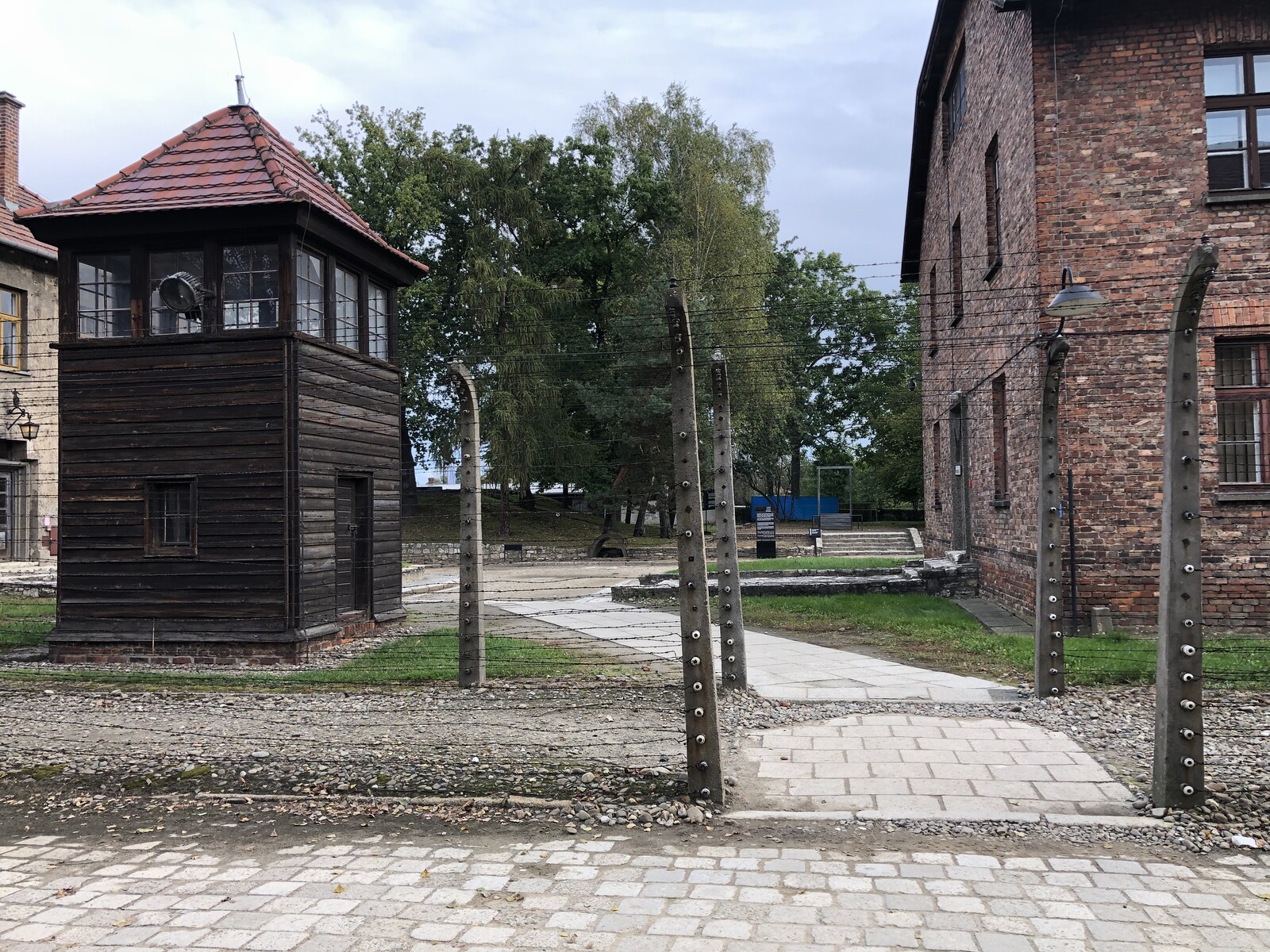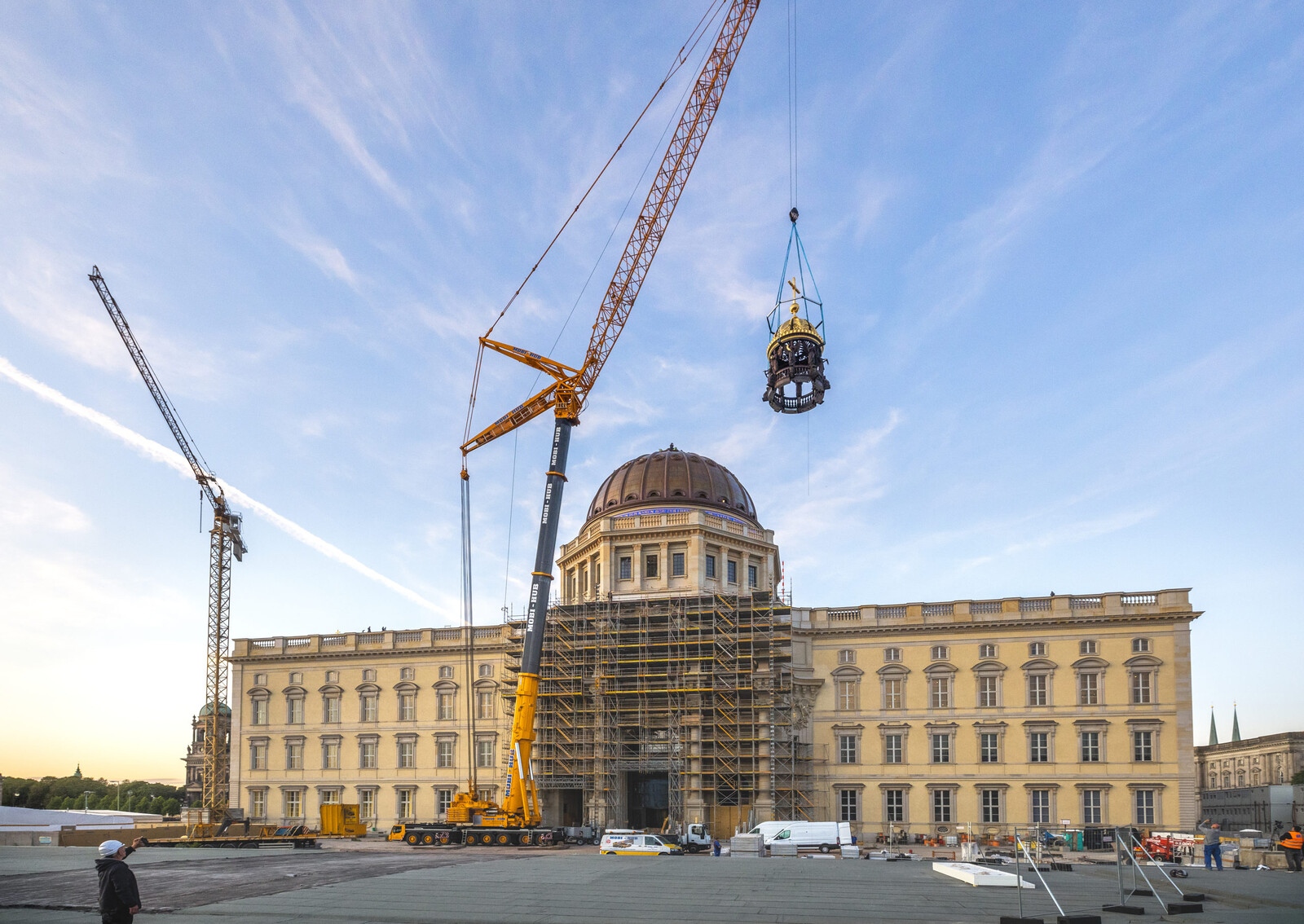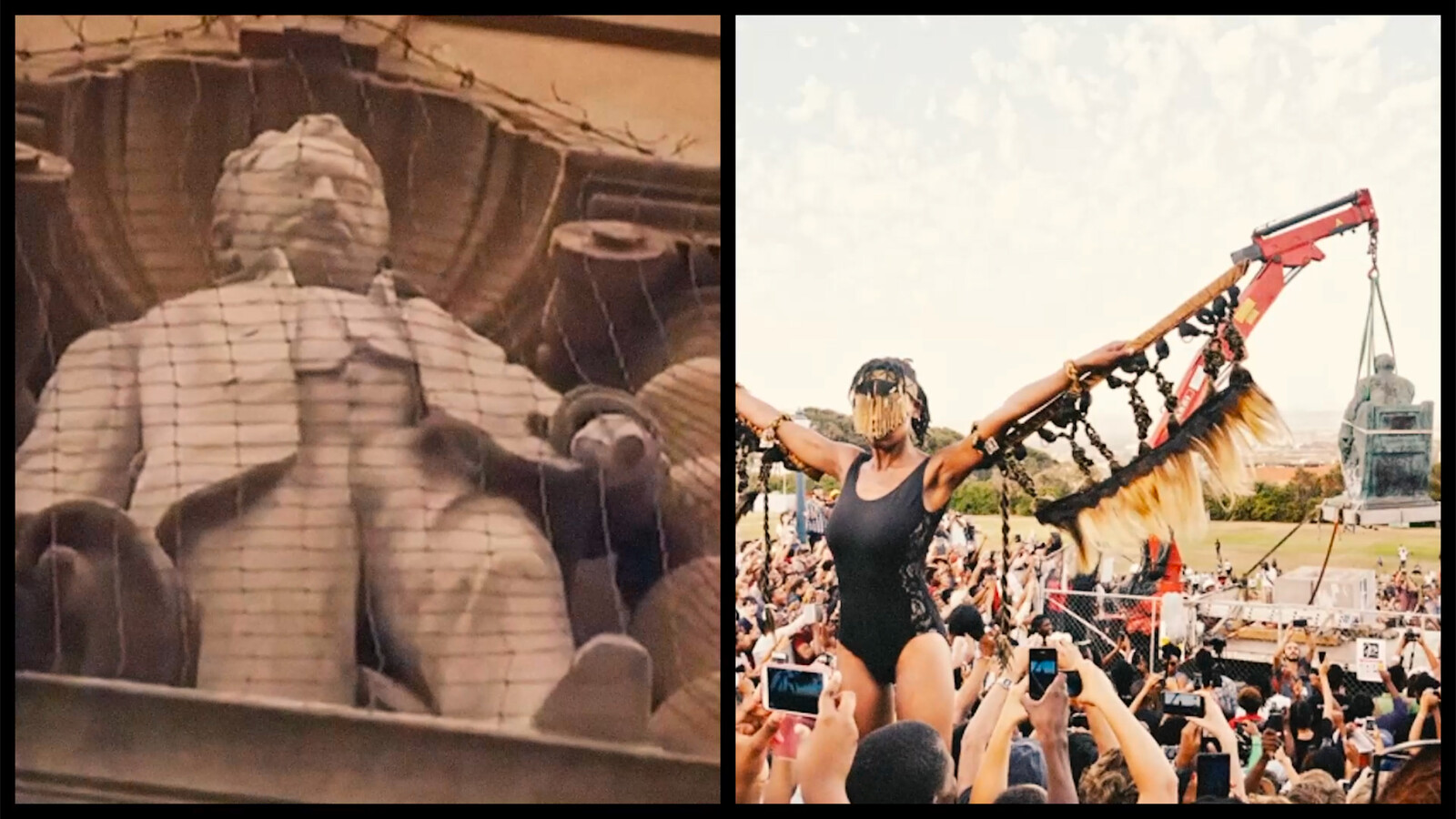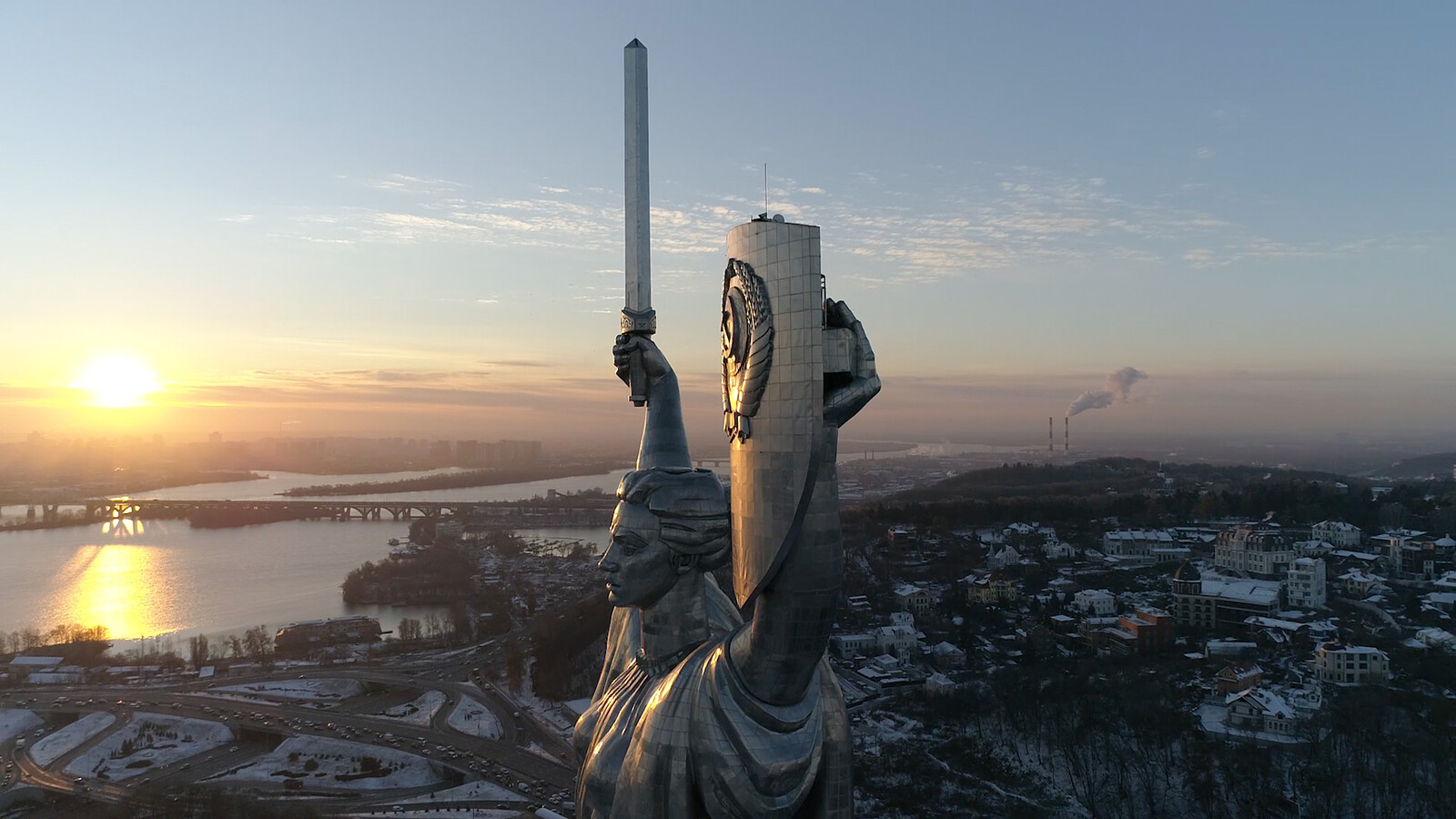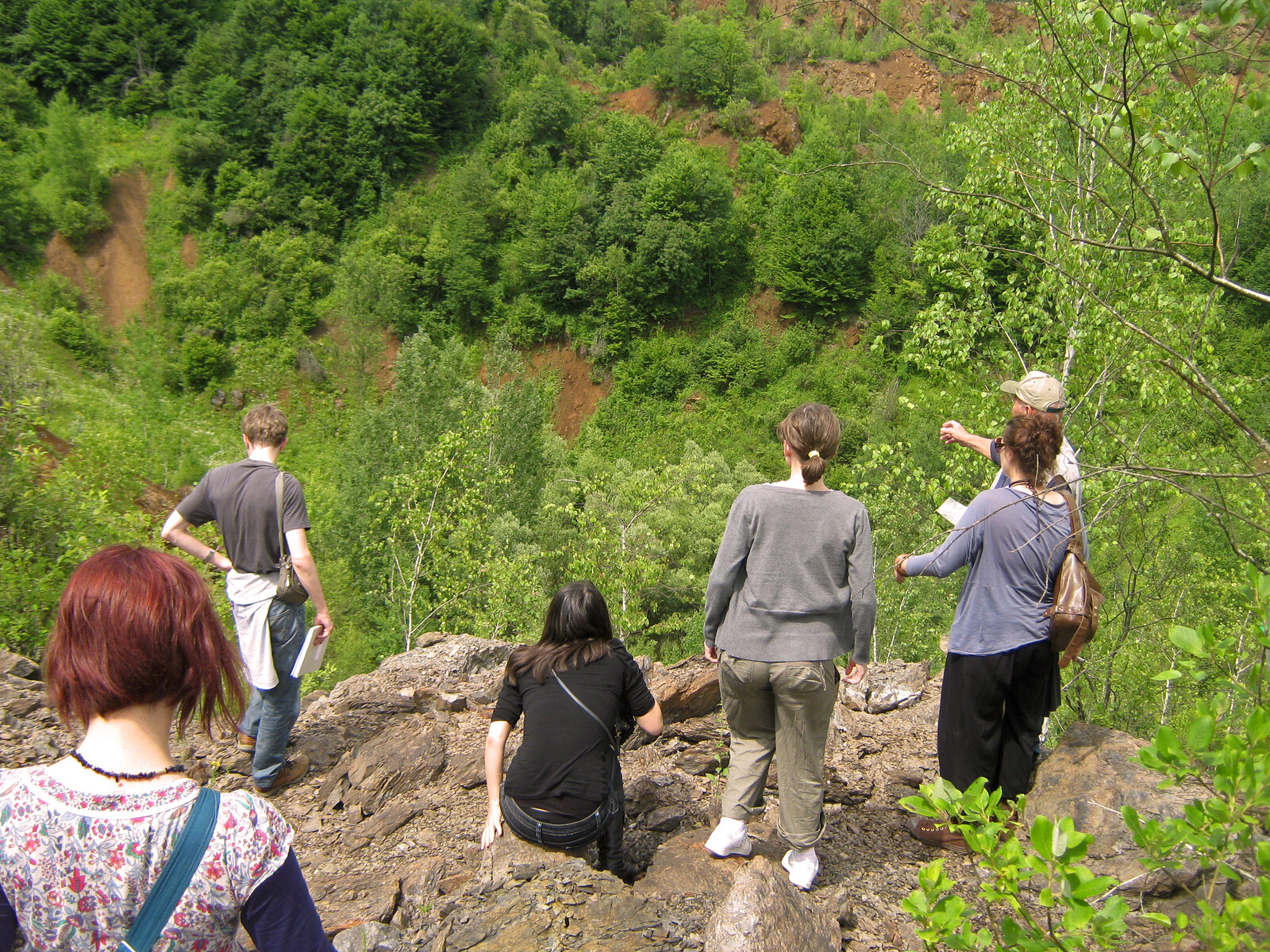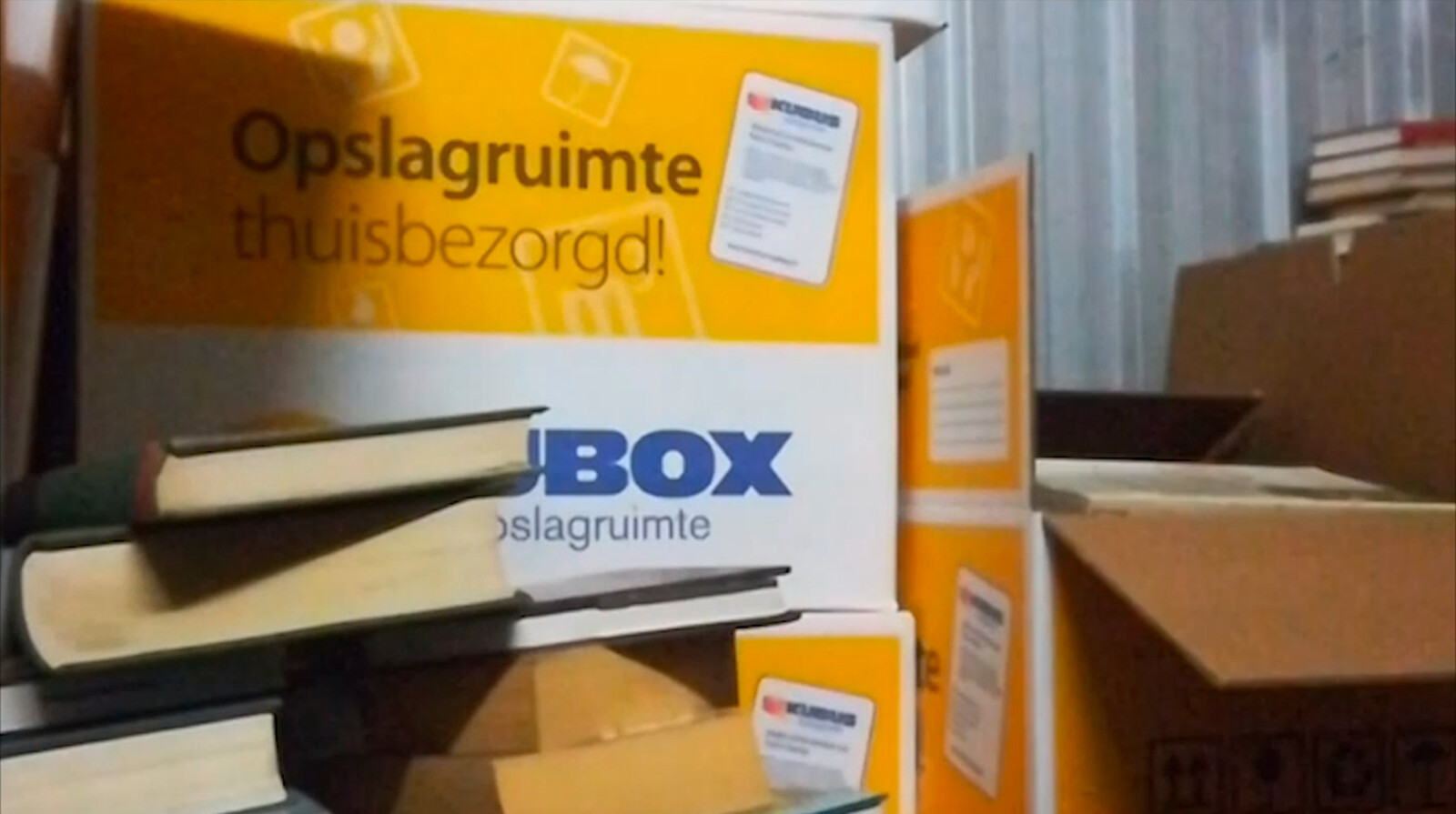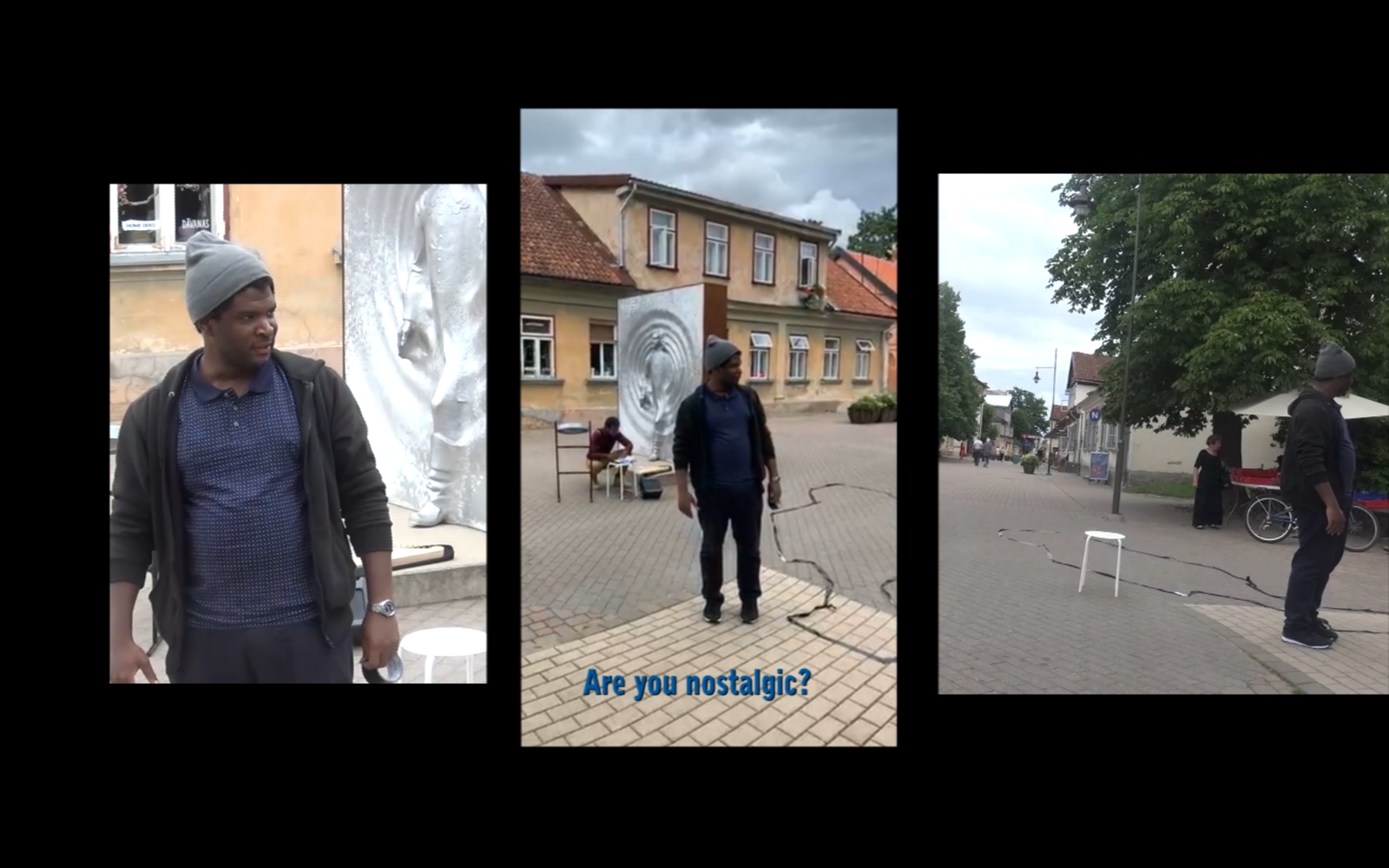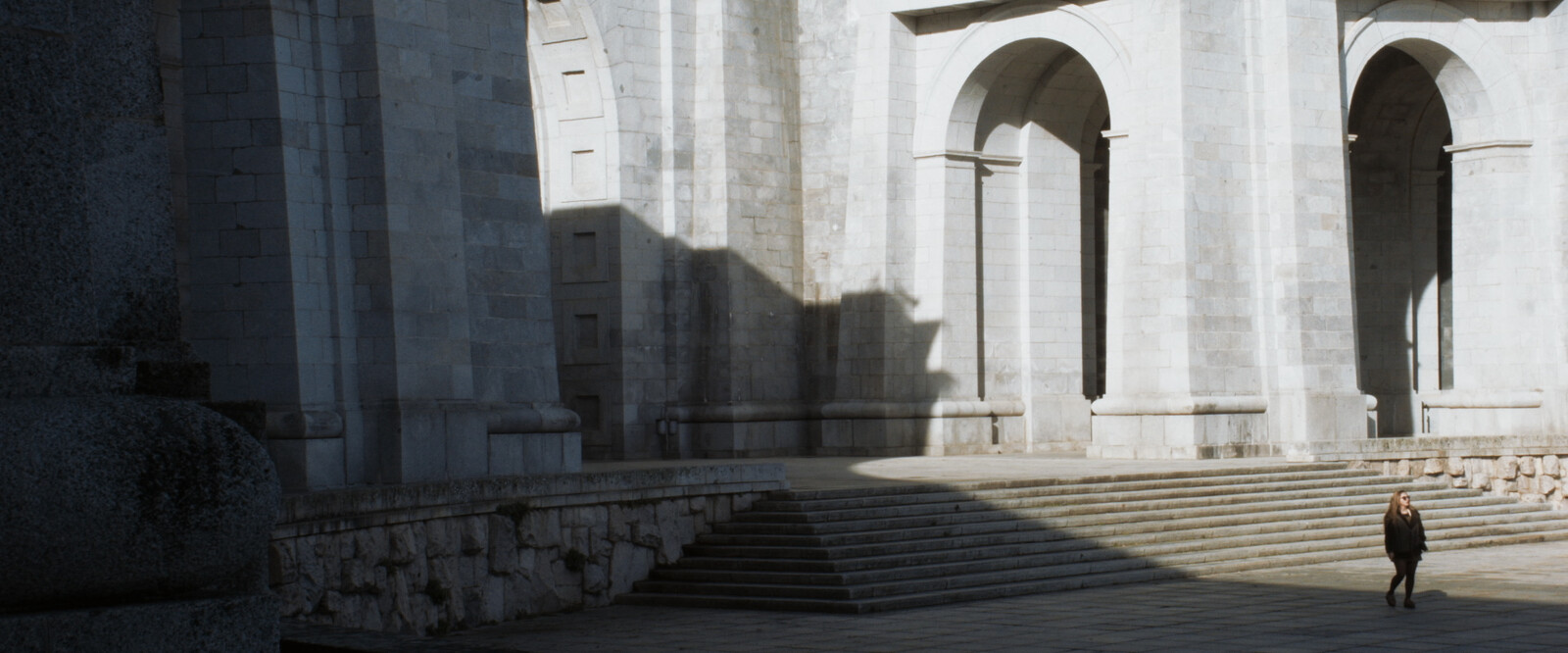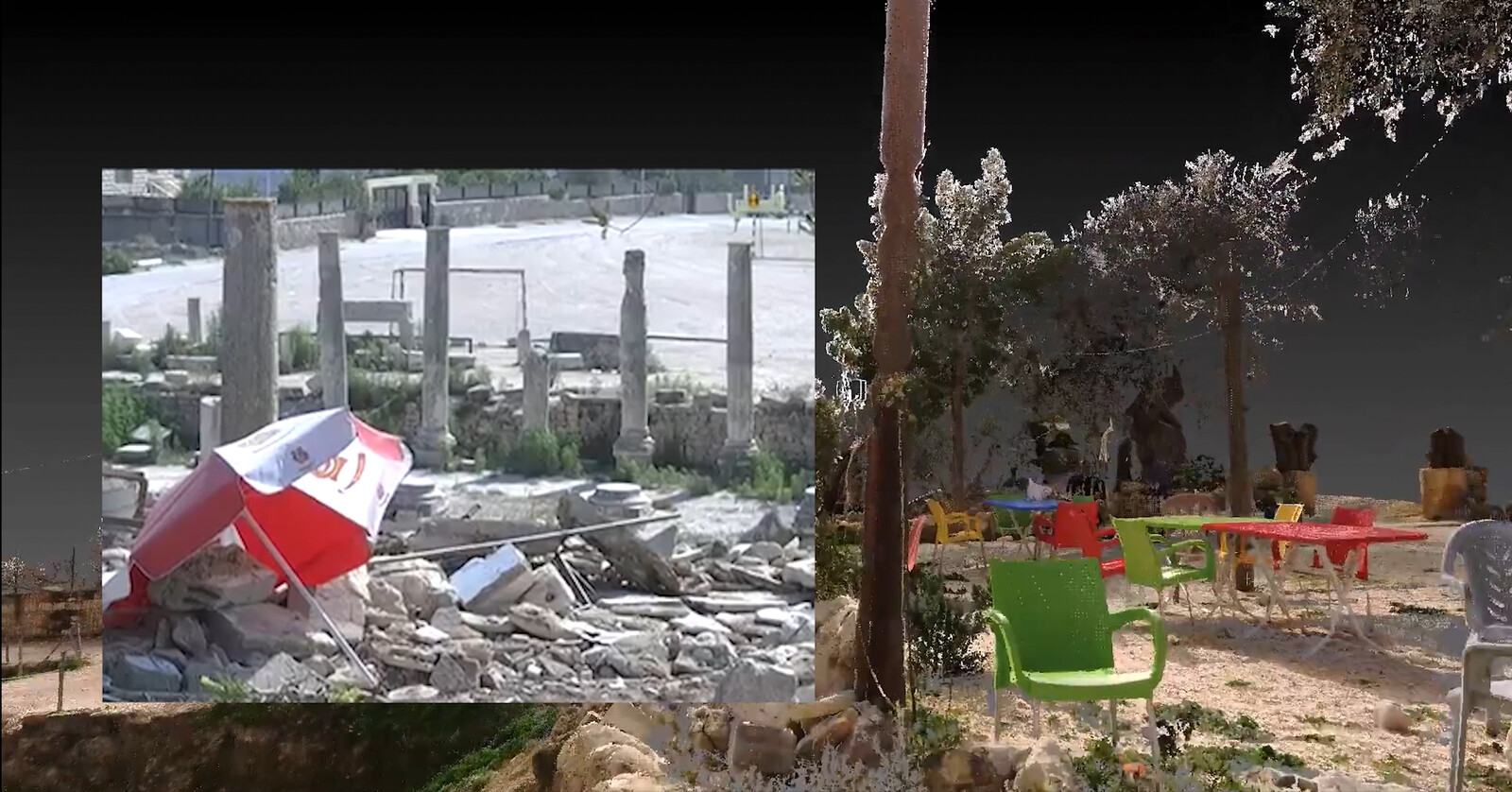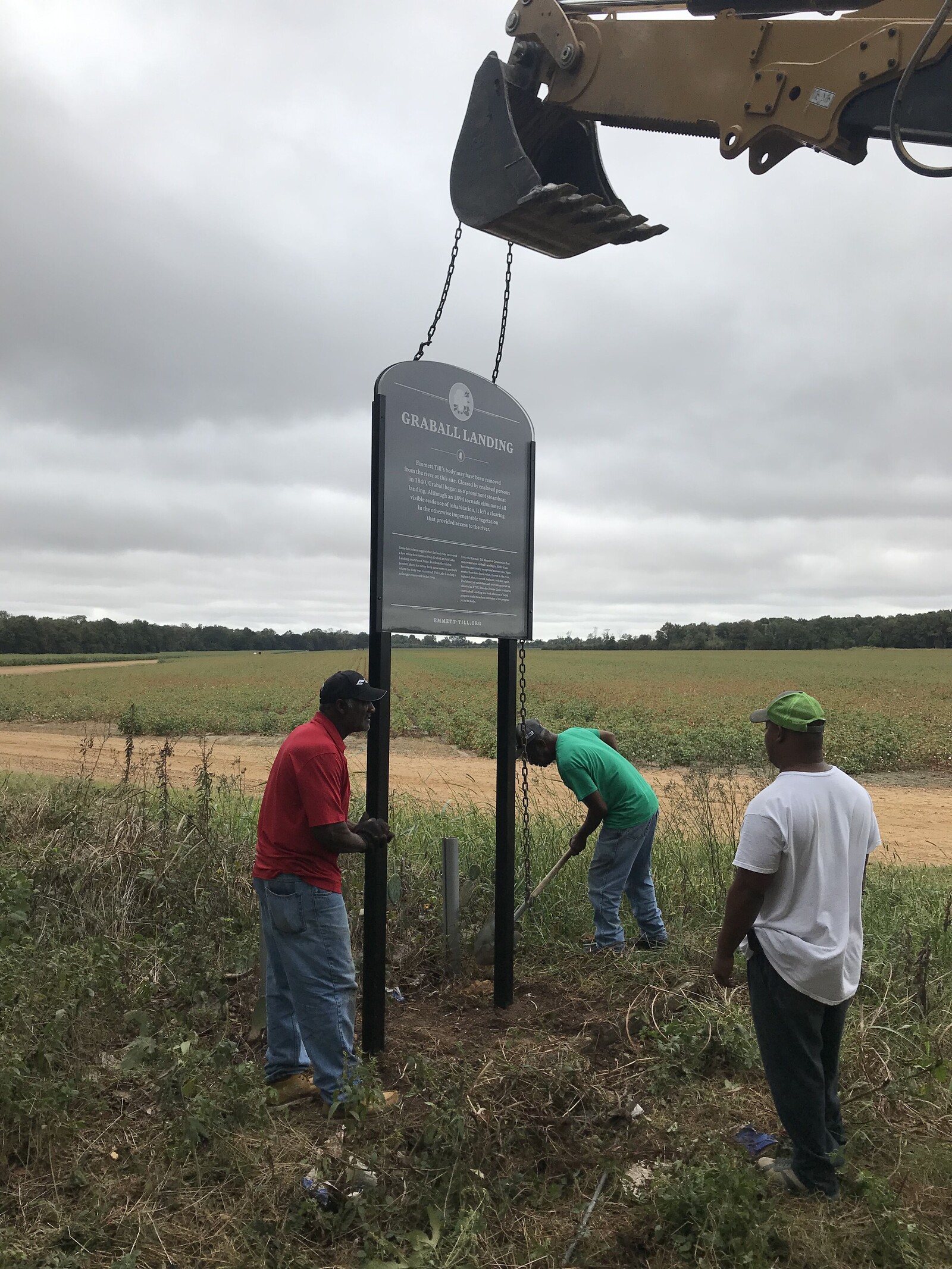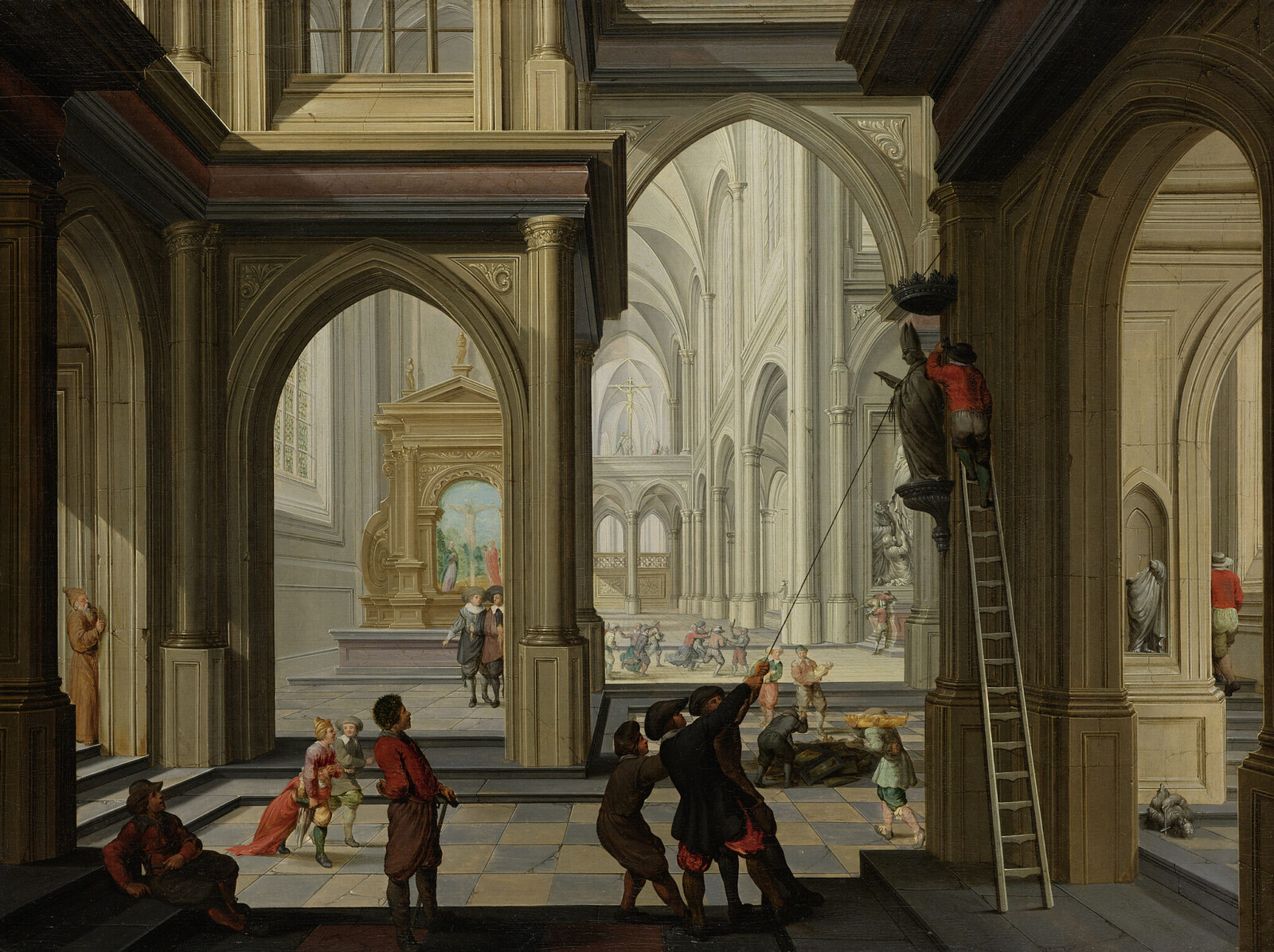And we, Spectators, always, everywhere,
looking at, never out of, everything!
It overfills us. We arrange it, It falls apart.
We rearrange it, and fall apart ourselves.
—Rainer Maria Rilke1
At least once a year I take a group of people on a multi-day visit to Auschwitz. At times the group is made up of university students or academics; at other times the group is part of an annual workshop for North American high school teachers preparing to teach the Holocaust. At the very beginning of the visit, before introducing the site, I take the group to a gap in the double barbed wire fence, near Crematorium I. The gap provides a convenient shortcut between the exhibitions in Blocks (barracks) 4, 5, 6, 7 and 11, located inside the compound, and the crematorium on the other side of the fence, so that visitors do not have to walk the lengthy route back to the entrance at the Arbeit Macht Frei (“Work sets you free”) gate. During the site’s operation as a concentration camp, this gate was the only point of communication between the space inside the fence and the outside. It was not until 1947, when the site became a museum, that the second opening was created.2
When we begin our visit at 9:00 in the morning, we are alone at the gap; most visitors following the prescribed route will need at least two hours to reach this point. I give the group some simple instructions. I ask half of them to form a line along the inside of the fence, with two meters between each person and standing 1.5 meters from the barbed wire. I ask the other half to go through the gap and do the same on the outside of the fence, directly opposite someone on the inside. Every time, there are some puzzled looks and awkwardness. But having traveled a long distance to “experience” Auschwitz under my guidance, everyone soon falls into position, facing someone else through two layers of barbed wire. I then ask them to simply look that person in the eyes, and to not stop until I say so. Before we start, I clarify: “This is not a staring contest. You may blink as much as you want. The question is not who is stronger, but what you see when you observe another person through a barbed wire fence, and what happens inside you when you know yourself to be observed through a barbed wire fence.” Then we begin.
The same reactions usually unfold: someone breaks down in tears within the first minute or two; one or two people break eye contact and step out of line; and after five minutes, the remaining faces show severe stress, even pain. By this point I call an end to the exercise and ask the group to explain what had just happened. The conversation always includes the sudden sense of being in Auschwitz, of having arrived, and some credit their tears to the stress caused by that. We talk about seeing another human being contained by a tool invented to control cattle in the American prairies. At this point I often ask the participants to touch the sharp barbs, and offer a quote from the French philosopher Olivier Razac:
The simple act of placing men behind barbed wire produces superimposed images of men and beasts. The technical polyvalence of barbed wire—its capacity to repel any living thing, whether a cow or a dog—produces a kind of shock when it is used to enclose people, shaking their certitude that they are human. It confirms their fate: like beasts, they are to be worked or slaughtered.3
The participants mostly nod in acknowledgment, but few would attribute their emotional reaction to the sudden perception of their colleagues as beasts. Normally, their salient concern is the contradiction between the barbed wire’s physical impenetrability and its optical transparency. The initial understanding of someone raised in the relative comfort and safety of North America, or someone who has never suffered abuse or profound humiliation themselves, is typically of perceiving one’s self as a subject, and the other as an object. This is then followed by a second sensation of being seen by the other, of being the perceived object in someone else’s gaze. If the first sensation engenders compassion, the second triggers a sense of exposure, vulnerability, even shame. This is more or less where we end up: the dialectic of guard and prisoner, prisoner and guard.
Today, to visit Auschwitz, or Buchenwald, or any other former concentration camp site preserved through massive government subsidies and sophisticated international fundraising campaigns, is to take part in the tourist industry alongside millions of others. The literary critic Paul Fussell distinguished the tourist from the explorer or traveler by their search for “that which has been discovered by entrepreneurship and prepared for [them] by the arts of mass publicity.”4 Whereas exploration or travel can guarantee or at least offer the possibility of adventure, a “good story” as reward for some measure of discomfort, tourism promises both ease and safety: everything will be taken care of, from transport and accommodation to food and entertainment, even tips.
Like other tourist destinations, most concentration camp memorial sites provide large parking lots to accommodate dozens of air-conditioned buses, clean toilets adhering to international hygiene standards, services in many international languages, a manicured landscape of ruins marked by discreet multilingual signs, tasteful exhibition spaces, shops selling books, DVDs, posters, or postcards, and on-site cafeterias. Close by, but no closer than propriety would allow, there are slightly more upscale restaurants and, somewhat farther, accommodations ranging from hostel dormitories to comfortable hotels offering queen-size beds and en suite bathrooms. Concentration camp memorial sites are listed and ranked in major tourist guidebooks according to their perceived historic significance and quality of tourist infrastructure. In the 2013 edition of Lonely Planet’s Europe on a Shoestring, Auschwitz-Birkenau is ranked #3 on the top six “Poland Highlights”—behind the gnome statues in Wroclaw, but ahead of the city of Gdańsk—but also merits a “Don’t Miss” feature, which claims (rather indisputably) that “few place names have more impact than Auschwitz.” The book goes on to provide practical information about sights, tour schedules, and easy 12-złoty bus connections from Kraków (the center of Poland’s tourist infrastructure, ranked #8 among Europe’s twenty-four top experiences).5
When visitors arrive at Auschwitz, most of them are seeing it for the first (and probably also the last) time. Yet they have all seen it before, in books, TV shows, movies, websites, and the like. The fences, guard towers, gates, barracks, crematoria of Buchenwald, Auschwitz, and Majdanek, and their subsequent memorials have become the visual icons of a well-meaning but otherwise vague “Never Again!” campaign that started after the end of the war. The proliferation of images and descriptions of tourist destinations, according to Fussell, inevitably produces a world of “pseudo-places” catering to the fantasies of tourists. Whereas places are “odd and call for interpretation,” pseudo-places “entice by their familiarity and call for instant recognition: ‘we have arrived.’”6 For those of us involved with the preservation and presentation of concentration camp memorial sites, there is still a sincere regard for these sites that remain (thankfully) odd and out-of-place amid a placeless consumerist present, and which continue to call for responsible interpretation. But even the most honorable efforts to safeguard a site as a genuine place are overwhelmed by the increasingly palpable presence of its corresponding pseudo-place, which visitors enact as a to-do list prepared in advance: fence: ✓; guard tower: ✓; gate: ✓ barrack: ✓; suitcase exhibit: ✓; hair exhibit: ✓; crematorium: ✓.
While this approach is lamentable, it doesn’t necessarily impinge upon the ability of other visitors to experience the site through other registers. But Fussell, writing in 1980, could not have foreseen the transformative effect of the personal smartphone on the tourist in their ability to distract and offend those others. In recent years, I have seen hundreds of teenagers taking selfies at the “Jedem das Seine” (“To each his own”) gate at Buchenwald, and countless twenty-somethings texting their friends from the gas chamber of the still-extant crematorium in the Auschwitz Stammlager. On one occasion under the domed roof of the mausoleum at Majdanek, I observed a middle-aged woman pleasantly engaged in a call and smoking a cigarette while sheltering from the rain. As she spoke, she absentmindedly tapped her cigarette against the edge of the massive circular urn in the center of the space, dropping her cigarette ashes into the collected ashes of thousands of people murdered at the site. Yet even this behavior may be expected when tourists are given the unconditional message: “Don’t Miss” these sites.
The first time I traveled to Auschwitz, shortly after the fall of the Berlin Wall, I did so alone, by train, and without much money, planned arrangements, return tickets, or a clear sense of what, if anything, I was going to find. I had seen pictures of the memorial, but I was looking for documents related to the making of the site, which I hoped to, but did not know I would find in the State Museum in Oswiecim (as the organization running the site was known at the time). I felt like an explorer, and within the limited extent of my personal career, I was indeed taking a risk to move my research focus from the safe territories explored in my graduate studies to the uncertain future I would face as an architectural historian specialized in death camps. The signs were hardly promising, if my applications for teaching positions in architecture schools were any indication. “We are, of course, intrigued by your thesis that Auschwitz is important for our understanding of contemporary architecture, but sadly our current plans do not accommodate your interests. We wish you courage and strength in your endeavors,” one rejection letter wrote. Outside of the archives, however, I was an ordinary traveler: my three-month stay in Poland was marred only by the kind of misadventure that arises when one suddenly enters a society in rapid and painful transformation.
In recent years, I arrive in Auschwitz as a tourist, or better as a guide in the service of tourists. Perhaps they are not the average tourists: those high school teachers, for instance, have already completed a forty-hour seminar on how to teach the Holocaust to teenagers (the question of whether one ought to teach the Holocaust to teenagers is assumed as a given). They have already committed two weeks of their time and spent thousands of dollars to fly from North America to Munich, where they board a bus tour following a long itinerary of stops before reaching Auschwitz.7 I helped conceive the tour in 2002, and accompany each group for the fourteen days, both a guide and as a scholar-in-residence. The tour follows a temporal sequence (the history of Nazism and the Holocaust from 1919 to 1945) within a spatial system (the road from Munich to Auschwitz), each place shedding light on a different theme: in Munich, the rise of Nazism; in Dachau, the beginning of state-sponsored terror in 1933; in Nuremberg, the Führer-cult of the mid-1930s; and in Weimar-Buchenwald, the ease with which civic society accommodated itself to terror. In Berlin and Sachsenhausen, they visit key sites in the decision-making process that led to the genocide of the Jews and the search for efficient killing methods; in Warsaw, the former ghetto where Jews were herded together as a mass of superfluous subhumans; in Tykocin, the mass graves left by the mobile killing units who spearheaded the murderous phase of the Holocaust; and in Treblinka, the traces of the extermination camp, the inevitable conclusion to the preceding developments. Finally, we travel, via Majdanek and Kraków, to Auschwitz, where we confront the remains of the largest and most infamous death factory. Every preparation is made to provide a quality experience, including detailed schedules, guided searches for historical traces on walking routes, and illustrated evening lectures. The logistical needs of the visitors have all been arranged in advance: every day, they are guaranteed hotel breakfast and dinner, a packed lunch on the air-conditioned coach (with a working toilet), and a clean bed in a shared room at night. Nothing is left to chance. Certainly, it is a journey that is characterized by a desire to provide a quality experience, but it is still a tourist trip. I refer to it, somewhat ironically, as the “HoloHop.”
The exercise I lead at the barbed wire fence is an attempt to unsettle the visitors in their tourist status—to introduce, through this unfamiliar circumstance of sharing another person’s gaze, the possibility of shame, fear, or self-doubt; a possibility inherent to being a traveler or explorer. Of course, everyone who visits Auschwitz expects to be confronted with horrifying historical records: photos of living corpses, photos of dead corpses, the kind of visual material released after Bergen Belsen was liberated in April 1945. But in reality, such images are rare anomalies in the documentary narrative of Auschwitz.8 Nevertheless, visitors preconceive of Auschwitz as a synecdoche for the Holocaust, drawing on its broader iconography of media images to and develop ways to cope with the specter of inhumanity in advance.
However, the tourist paradigm offers little guidance or preparation for dealing with the sense of shame, of one’s own nakedness. As Friedrich Nietzsche observed in Morgenröthe (Daybreak): “The feeling ‘I am the mid-point of the world!’ arises very strongly if one is suddenly overcome with shame; one then stands there as though confused in the midst of a surging sea and feels dazzled as though by a great eye which gazes upon us and through us from all sides.”9 The sensation of being in the spotlight or at the center of the world (if only for an instant) induces an acknowledgement of obligation and responsibility that disturbs the tourist experience, with its leisurely, effortless and essentially thoughtless consumption of place. The same dynamic applies to the sensation of being alone and in need of the other, which Jean-Paul Sartre ascribed to the shame of being seen as no more than an object: “Shame is the feeling of an original fall, not because of the fact that I may have committed this or that particular fault but simply that I have ‘fallen’ into the world in the midst of things and that I need the mediation of the Other in order to be what I am.”10 The experience at the gap alters the group dynamics, creating a heightened bond that transcends the shared pleasures of sight-seeing previously experienced on the trip.
The dimension of shame, but also the attendant feeling of confusion, rage, and even a desire for a measure of interpersonal justice were, perhaps more than anyone else, explored in the writing of Primo Levi, an Italian chemist who was deported to Auschwitz in early 1944. In his last book, I sommersi e i salvati (The Drowned and the Saved), Levi describes his arrival at Auschwitz expecting to find a spirit of solidarity, and his shock upon discovering it did not exist within the camp. Levi expected to find “a terrible but decipherable world, in conformity with that simple model which we atavistically carry within us—‘we’ inside and the enemy outside, separated by a sharply defined geographic frontier.” Yet this did not happen. “The world into which one was precipitated was terrible, yes, but also indecipherable: it did not conform to any model; the enemy was all around but also inside, the ‘we’ lost its limits.” In Auschwitz, Levi encountered the inmates not as “companions in misfortune,” but as opponents: one’s neighbor posed a greater threat to one’s safety or survival than a guard: “the instant form of a concentric aggression on the part of those in whom one hoped to find future allies, was so harsh as to cause the immediate collapse of one’s capacity to resist.”11
Thanks to his professional skills and a great deal of luck, Levi was spared death during his imprisonment in the Auschwitz satellite camp near Monowitz. In 1944, the Germans selected a few Häftlinge (prisoners) who had studied chemistry to work in the laboratory of the synthetic rubber factory attached to the camp. As recounted in Levi’s 1946 memoir of Auschwitz, Se questo è un uomo (If this is a man), the selection was made through an exam given by Doktor Ingenieur Pannwitz. It was, as Kapo (inmate foreman) Alex said, “a madman’s dream. With these empty faces of ours, with these sheared craniums, with these shameful clothes, to take a chemical exam.” Alex brings Levi to Pannwitz’s office where he meets the examiner’s gaze, triggering an episode of rage—the only one during his entire stay in Auschwitz:
When he finished writing, he raised his eyes and looked at me… that look was not one between two men; and if I had known how completely to explain the nature of that look, which came as if across the glass window of an aquarium between two beings who live in different worlds, I would also have explained the essence of the great insanity of the third Germany.
One felt in that moment, in an immediate manner, what we all thought and said of the Germans. The brain which governed those eyes and those manicured hands said: “This something in front of me belongs to a species which it is obviously opportune to suppress. In this particular case, one has to first make sure that it does not contain some utilizable element.”12
Levi’s skills give him some protection until January 1945, when he fell ill and was admitted to the camp hospital, a death sentence at the time. In the face of the Red Army’s approach, the SS evacuated the camps in early 1945, intending to kill the prisoners who could not join the march to the west. But an air raid and fear of the imminent arrival of the Red Army made the SS panic and flee, leaving Levi and 800 sick and dying prisoners behind in Monowitz, without food or water. In the ten days between the departure of the Germans and the arrival of the Russians, hundreds of these prisoners died, and the rest survived in terrible conditions. On the ninth day, Levi recalls:
January 26. We lay in a world of death and phantoms. The last trace of civilization had vanished around and inside us. The work of bestial degradation, begun by the victorious Germans, had been carried to its conclusion by the Germans in defeat.
It is man who kills, man who creates or suffers injustice; it is no longer man who, having lost all restraint, shares his bed with a corpse. Whoever waits for his neighbor to die in order to take his piece of bread is, albeit guiltless, further from the model of thinking man than the most primitive pigmy or the most vicious sadist… This is why the experience of someone who has lived for days during which man was merely a thing in the eyes of man is non-human.13
One of Levi’s fellow prisoners, a fifty-year old Hungarian-Jewish chemist named Sómogyi, dies that evening. The next morning, as he carries the body to the mass grave, Levi mentions: “The Russians arrived while Charles and I were carrying Sómogyi a little distance outside. We overturned the stretcher on the grey snow.”14 He wrote nothing more at the time of the liberation—a clear indication that the world the Germans had created in Auschwitz could not be unmade. In La tregua (The Truce, 1963), however, Levi’s memoir of the journey home, he goes into more detail:
The first Russian patrol came in sight of the camp about mid-day on 27 January 1945… When they reached the barbed wire, they stopped to look, exchanging a few timid words, and throwing strangely embarrassed glances at the sprawling bodies, at the battered huts and at us few still alive… They did not greet us, nor did they smile; they seemed oppressed not only by compassion but by a confused restraint, which sealed their lips and bound their eyes to the funereal scene. It was that shame we knew so well, the shame that drowned us after the selections, and every time we had to watch, or submit to, some outrage: the shame the Germans did not know, that the just man experiences at the other’s crime; the feeling of guilt that such a crime should exist, that it should have been introduced irrevocably in the world of things that exist, and that his will for good should have proved too weak or null, and should not have availed in defense.15
In 1961, the year that Levi’s Auschwitz chronicle was published in Germany (Ist das ein Mensch?), he was working as the director of a paint and varnish factory. While there, he happened to come across a name from the laboratory at Auschwitz-Monowitz—a German chemist named Doktor Müller, who had been Doktor Pannwitz’s assistant and Levi’s immediate supervisor. In his memoir Il sistema periodico (The Periodic Table) Levi recalled that Müller “had spoken to me only three times, and all three times with a timidity rare in that place, as if he were ashamed of something.” Since his liberation from Auschwitz, Levi had desired to have a moment of reckoning with one of the Germans whom he had encountered in the camp:
The encounter I looked forward to with so much intensity as to dream of it (in German) at night, was an encounter with one of them down there, who had disposed of us, who had not looked us in the eyes, as though we didn’t have eyes. Not to take my revenge: I am not the Count of Montecristo. Only to reestablish the right proportions, and to say, “Well?”16
Levi wrote to Müller, identifying himself as the nameless inmate who had worked for him. Müller responded by confirming his identity, and so began a correspondence between the two, in which Levi asked tough questions, and Müller responded with attempts at explanation and conciliation in the spirit of “overcoming that terrible past.” Levi tried to withhold judgment.17 Müller frequently asked for an eye-to-eye meeting, and one day he called Levi, tense and agitated, saying that he planned to travel to the Italian Riviera. A surprised Levi agreed to a meeting, but eight days later, he “received from Mrs. Müller the announcement of the unexpected death of Doktor Lothar Müller in his sixtieth year of life.”18
While visiting Auschwitz with students or high school teachers, I share the stories of Levi’s arrival in the camp and his encounters with Dr. Pannwitz, the four Russian soldiers and Dr. Müller later on the same day that we have gazed at each other through the double barbed-wire fence close to the gap. Levi’s narrative of confusion, rage, shame, and a most gentle revenge offers an opportunity to provide a language for the experience at the gap, to expand the conversation beyond the all too obvious dialectic between prisoner and guard, guard and prisoner. Hannah Arendt famously observed: “storytelling reveals meaning without the error of defining it.”19 One unexpected experience in which we see each other in a new light, and a few stories about seeing and being seen: all of this in order to help the students or the teachers to imagine the place as if they had never heard about it before, as if they were seeing it for the first time.
The time we spend at the gap in the barbed wire fence is thus a small act of resistance undertaken in the vain hope that, even today, if only for a moment, it is possible to transform a pseudo-place back into a place—or as the Germans would say, a genuine Ort, a word that originally meant the tip of a spear, in which everything runs together and which, when it hits a living being, creates a wound where being’s being gathers, in pain, and consciousness.20 Looking at each other through the barbed wire fence, I ask the members of my group to transform their gazes into spears, gazes into wounds. And absorbing the point of the stories, they discover the words to share their experience. If the feedback I received has been earnest, it appears that none of those who participated in this formality simply checked off the experience, if only because it did not appear on a to-do-list. (Of course, it did on my own list, and every time I make a mental note after our short sojourn at the gap in the fence: gazes returned: ✓.) It has proven itself to be just enough to shake their expectations about the trip, and generate a sense that, perhaps, they did not arrive at a place they have already seen.
Rainer Maria Rilke, Duino Elegies, trans. Edward Snow (New York: North Point Press, 2000), 51.
The gap in the fence has even earned a place in travel guides. Thus the instruction given in Rick Steves Eastern Europe, one of the best English-language guides to the region: “Before you leave Auschwitz, visit the crematorium (from Block 11, exit straight ahead and go past the first row of barracks, then turn right and go straight on the road between the two rows of barracks; pass through the gap in the fence and look for the chimney on your left).” Rick Steves Eastern Europe, 7th edition, eds. Rick Steves and Cameron Hewitt (Berkeley: Avalon Travel, 2012), 372.
Olivier Razac, Barbed Wire: A Political History, trans. Jonathan Kneight (New York: The New Press, 2002), 89.
Paul Fussell, Abroad: British Literary Traveling Between the Wars (New York and Oxford: Oxford University Press, 1980), 39.
Tom Masters et al., Europe on a Shoestring (Melbourne: Victoria, 2013), 14, 817, 825.
Fussell, Abroad, 42–3.
The program is organized by the American charity The Jewish Foundation for the Righteous (JFR). This organization supports non-Jews who risked their lives to rescue Jews during the Holocaust with pensions and medical help, and, upon their death, with a funeral and a gravestone. The JFR also runs an education program to prepare middle- and high-school teachers to teach Holocaust history.
When the Red Army liberated Auschwitz in January 1945, it was mostly empty, while Belsen was overflowing with prisoners and unburied corpses when the British Army opened its gates in April 1945. And while the British soldiers entering Belsen were accompanied by a team of professional photographers and a film team, the units of the Red Army were badly equipped to make pictures during operations.
Friedrich Nietzsche, Daybreak: Thoughts on the Prejudices of Morality, trans. Reginald John Hollingdale (Cambridge: Cambridge University Press, 1997), 352.
Jean-Paul Sartre, Being and Nothingness: An Essay on Phenomenological Ontology, trans. Hazel E. Barnes (London and New York: Routledge, 2003), 312.
Primo Levi, The Drowned and the Saved, trans. Raymond Rosenthal (New York: Simon and Schuster, 1986), 37–38.
Primo Levi, If this is a man, trans. Stuart Woolf (New York: The Orion Press, 1959), 122–123.
Ibid., 204–5.
Ibid., 206.
Primo Levi, The Truce, trans. Stuart Woolf (London: The Bodley Head, 1965), 11–12.
Primo Levi, The Periodic Table, trans. Raymond Rosenthal (New York: Schocken, 1984), 214–215.
In the end, he articulated the following insight into Müller’s personality: “Neither infamous nor a hero: after filtering off the rhetoric and the lies in good or bad faith there remained a typically gray human specimen, one of the not so few one-eyed men in the kingdom of the blind…He was not cowardly, or deaf, or a cynic, he had not conformed, he was trying to settle his accounts with the past and they didn’t tally: he tried to make them tally, perhaps by cheating a little bit. Could one ask much more from an ex-SA?” Ibid., 221–222.
Ibid., 223.
Hannah Arendt, “Isak Dinesen 1885–1963,” in Men in Dark Times (New York: Harcourt, Brace & World, 1968), 105.
See Martin Heidegger, “Language in the Poem,” in On the Way to Language, trans. Peter D. Herz (New York: Harper & Row, 1971), 159.
Monument is a collaboration between e-flux Architecture and Het Nieuwe Instituut.
